World Refugee Day is an international day designated by the United Nations to honour refugees around the globe. It falls each year on June 20 and celebrates the strength and courage of people who have been forced to flee their home country to escape conflict or persecution. World Refugee Day is an occasion to build empathy and understanding for their plight and to recognize their resilience in rebuilding their lives.
World Refugee Day shines a light on the rights, needs and dreams of refugees, helping to mobilize political will and resources so refugees can not only survive but also thrive. While it is important to protect and improve the lives of refugees every single day, international days like World Refugee Day help to focus global attention on the plight of those fleeing conflict or persecution.
COVID-19 has posed an additional threat on people on the move and trapped populations. Experts in the partner institutions in the Bonn Alliance for Sustainability Research align their results and insights on the topic “refugees and trapped populations under COVID-19” in a social media campaign, highlighting core messages and key points from their recent publications on the matter:
1. Exploring the impact of multidimensional refugee vulnerability on distancing as a protective measure against COVID-19: The case of Syrian refugees in Lebanon and Turkey
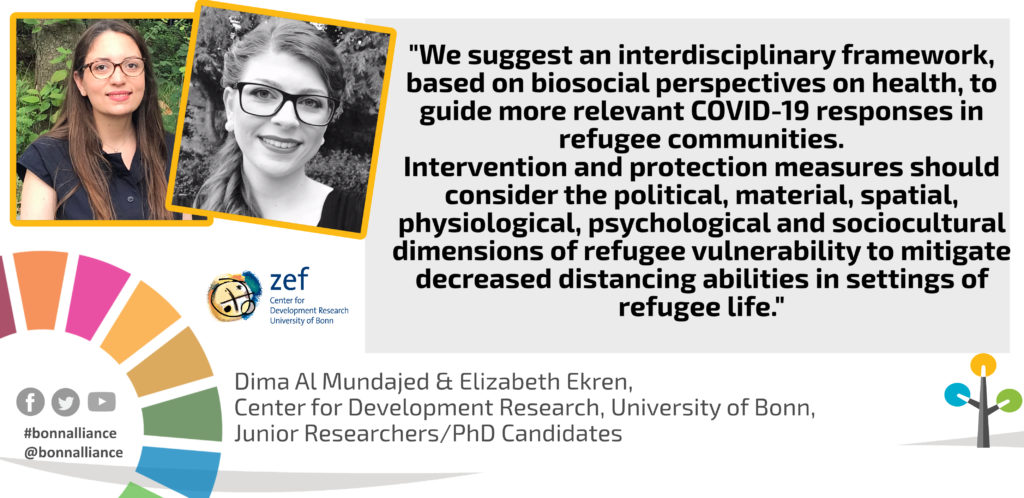
Background
The unequal physiological and socioeconomic consequences of the COVID-19 pandemic across the world are revealing the multidimensional components of health and vulnerability. As governments have pushed physical and social distancing as protective strategies, this study explores the extent to which this approach is relevant for Syrian refugees living in Lebanon and Turkey.
Methods
This qualitative study draws on 11 interviews with refugee experts and development practitioners (3) and Syrian refugee families (4 from Turkey, 4 from Lebanon) during the COVID-19 pandemic, as well as a review of recent literature. In addition, it draws on 71 semi-structured interviews with staff at NGOs supporting refugees (48 from Turkey, 23 from Lebanon) collected in 2018. Qualitative data analysis software ATLAS.ti 8 was used to perform content-based thematic analysis using both deductive and inductive coding.
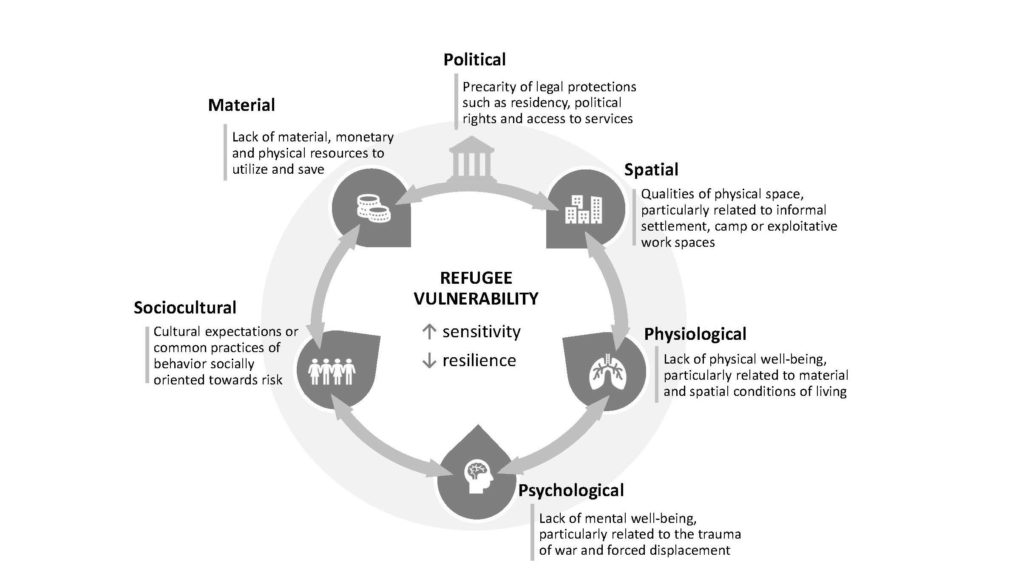
Findings
The study finds that distancing—physically and socially—can be ineffective as a disease protection strategy in Syrian refugee communities. This is influenced by six major interconnected dimensions of refugee vulnerability—political, material, spatial, physiological, psychological and sociocultural—which collectively form an interdisciplinary framework to guide more relevant COVID-19 interventions in refugee communities. The inability to distance is not necessarily rooted in lack of knowledge. Rather, when the inside conditions of living are crowded and unhygienic, but also include cultural expectations of familial care, and the outside conditions of survival-necessitated work are perpetuated through precarious political protections, distancing becomes impractical in application, despite the sense of internalized responsibility to keep one another safe.
Conclusions
The findings suggest that more relevant COVID-19 interventions and protection measures must consider the non-physiological manifestations of disease across multiple dimensions of vulnerability to mitigate decreased distancing abilities in settings of refugee life.
Authors: Dima Al Mundajed & Elizabeth Ekren (Center for Development Research, University of Bonn, Junior Researchers/PhD Candidates)
2. COVID-19 in India: Who are we leaving behind?
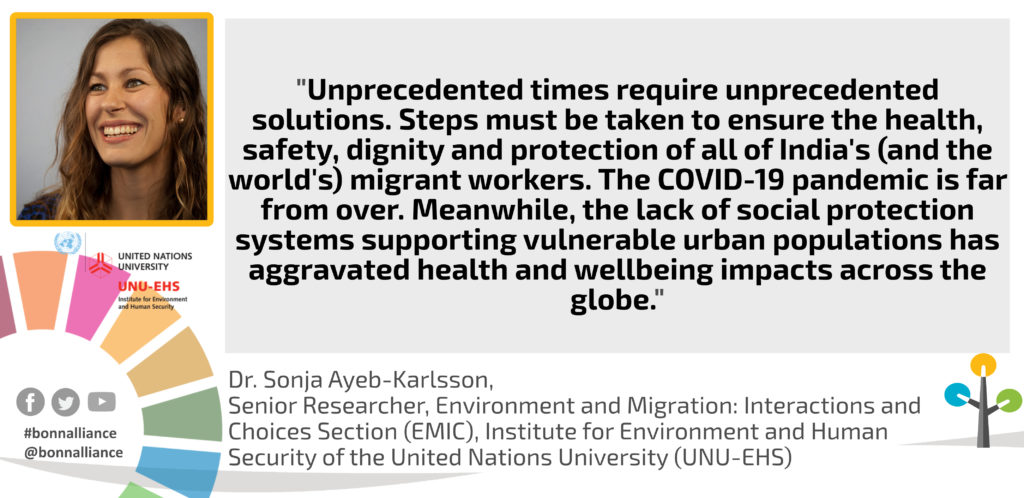
Abstract
The COVID-19 pandemic has uncovered and intensified existing societal inequalities. People on the move and residents of urban slums and informal settlements are among some of the most affected groups in the Global South. Given the current living conditions of migrants, the WHO guidelines on how to prevent COVID-19 (such as handwashing, physical distancing and working from home) are challenging to nearly impossible in informal settlements. We use the case of India to highlight the challenges of migrants and urban slum dwellers during the COVID-19 response, and to provide human rights-based recommendations for immediate action to safeguard these vulnerable populations.
Author: Dr. Sonja Ayeb-Karlsson,
Senior Researcher, Environment and Migration: Interactions and Choices Section (EMIC), Institute for Environment and Human Security of the United Nations University (UNU-EHS)
Other topic related publications
1. COVID-19: How do you self-isolate in a refugee camp? [May 8, 2020]
2. How can we protect refugees during the COVID-19 crisis? [May 15, 2020]
3. How do you self-isolate in a refugee camp? [December 1, 2020]
3. Turkey’s return policies to Syria & their impacts on migrants and refugees’ human rights
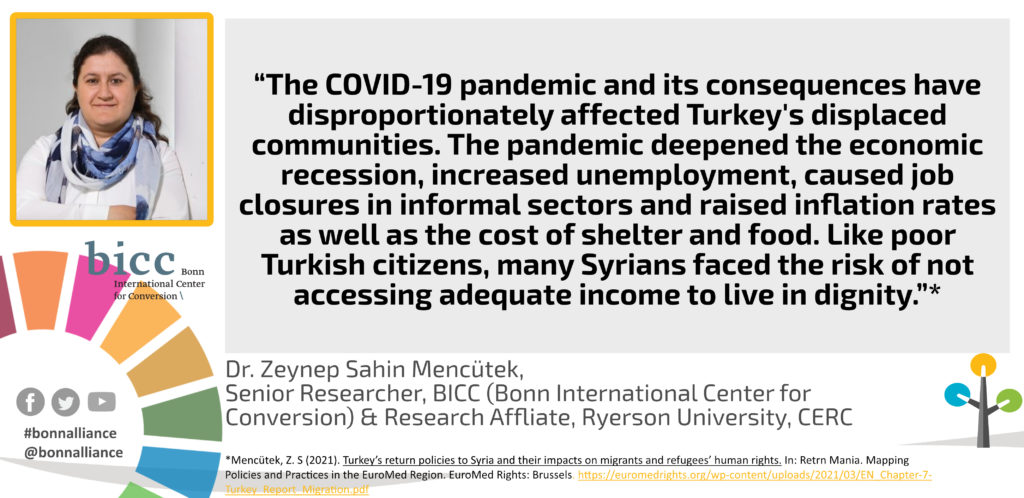
4. Migrants face a dilemma during COVID-19: uncertainty at home or abroad?
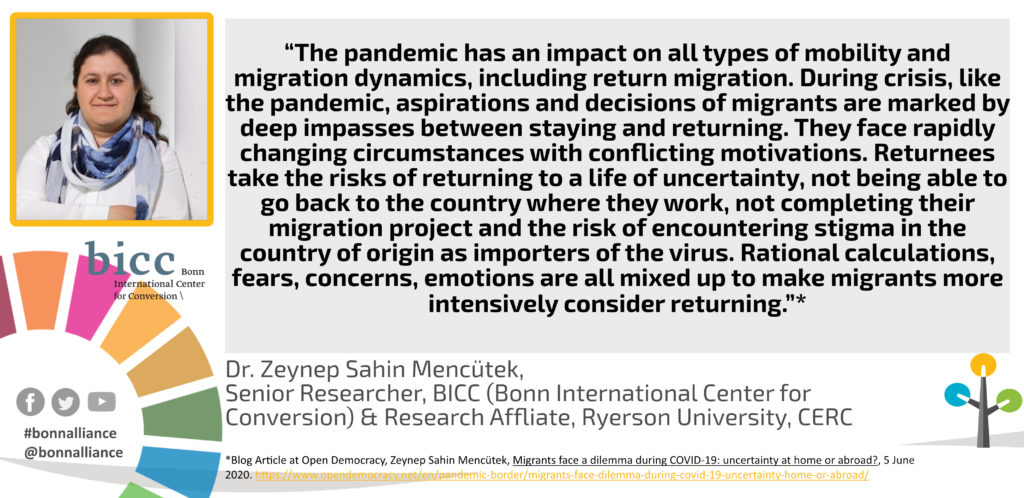
Other topic related publications
1. “Transnational Governance of Migrant Returns in Pandemic Times”
[April 22-23, 2021]
Abstract
The Covid-19 crisis prompted many migrant workers, irregular migrants, including asylum seekers, and those stranded in transit zones to evaluate the option of returning to their home countries. Actual returns occur across the globe with small and high numbers due to the ensuing lockdowns and difficulties accessing income and protection. Receiving, sending, and transit countries and international organizations are involved in return operations. The International Organization of Migration (IOM) took an active role by working with regional governments in Africa, Latin America, and Asia to facilitate the return of thousands of stranded migrants in transit places. It opened ‘humanitarian corridors’ by collaborating and negotiating with the origin and host countries. Besides its material logistics provision, it also invested in information campaigns and communications with crisis-affected communities and governments to legitimize its operations and to highlight its compliance with international norms on returns.
This study focuses on how ‘times of crisis’ help IOM maintain its rising role in global migration governance architecture, particularly in challenging policy fields like returns in which origin countries are often reluctant to cooperate. Also, how power asymmetries between origin and receiving countries, on the one hand, deep imbalances among migrants and states’ capacities on the other hand, affect return practices in multiple crises. An emphasis on these questions provides us with broader insights to evaluate migration governance practices’ characteristics in ‘pandemic times’ and transnational governance constellations.
Source: Conference Paper presentation “Transnational Governance of Migrant Returns in Pandemic Times” “22 – 23 April 2021. Ideas for Re-ordering the World in Times of Multiple Crises: Continuity and Change beyond Covid-19, 3rd Annual Conference, Käte Hamburger Kolleg/Centre for Global Cooperation Research and Institute for Development and Peace (INEF).
2. “Voluntary and Forced Return Migration under a Pandemic Crisis”
[Book Chapter, publication in fall 2021]
Abstract
The Covid-19 pandemic has an impact on migrants’ return decision and actual returns. Border closures in the face of pandemic lead to the panic mobility of those returning home across the globe. The ensuing lockdowns and economic difficulties restricted migrant workers’ access to income and protection, pushing them to return. The pandemic also brought evident risks for the highly skilled migrants’ access to healthcare, financial security, and social protection, forcing them to consider the return option too. For irregular migrants, the pandemic increased the risk of forced returns, including detention, deportation, and pushbacks. For all migrants, decisions are marked by a deep dilemma between staying and returning. Meanwhile, receiving, sending, and transit countries, as well as international organisations are involved in return processes by providing logistics, on the one hand, and stigmatising returnees as carriers of virus, on the other. This study is based on desk research and analysis of the scholarly literature, reports, and grey literature from international organizations, civil society reports, scientific blogs, and media reports. An emphasis on returns provides us broader insights to evaluate changing characteristics of migration and mobility in ‘pandemic times’, the governance of returns, its consequences, and the rhetoric about returnees.
Source: Book Chapter, Mencütek, Z. S. (forthcoming) Voluntary and Forced Return Migration under a Pandemic Crisis, In Migration and Pandemics: Spaces of Solidarity and Spaces of Exception, edited by Anna Triandafyllidou. (Under publication for IMISCOE and will be published in Fall 2021.)
5. Economic integration into host communities in times of crisis. How to ease the impact of Covid-19 on displaced populations in low- and middle-income countries
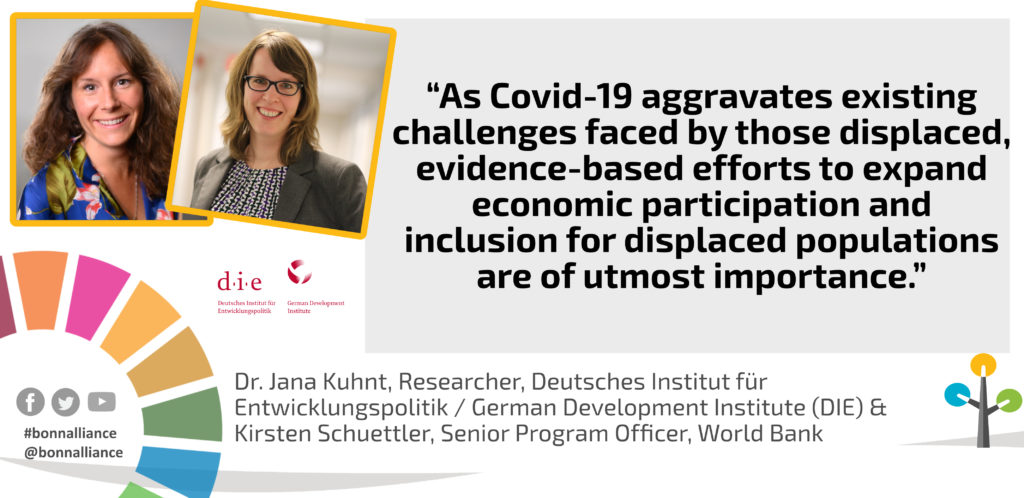
Abstract
Access to the labour market plays an essential role in allowing displaced populations to sustain their livelihoods and integrate into their host community. However, evidence shows that displaced people face specific challenges in integrating into the labour market. Covid-19 further aggravates these challenges. This policy brief presents evidence on interventions to ease the impact of the Covid-19 pandemic on the livelihoods of displaced populations, in the short term during lockdowns and in the medium and longer term under remaining restrictions and changed economic structures.
Authors: Dr. Jana Kuhnt (Deutsches Institut für Entwicklungspolitik / German Development Institute, Researcher) & Kirsten Schuettler (World Bank, Senior Program Officer)
6. In the shadow of the pandemic: Who has a right to mobility – and who doesn’t? \ Im Schatten der Pandemie: Wer hat ein Recht auf Mobilität – und wer nicht?
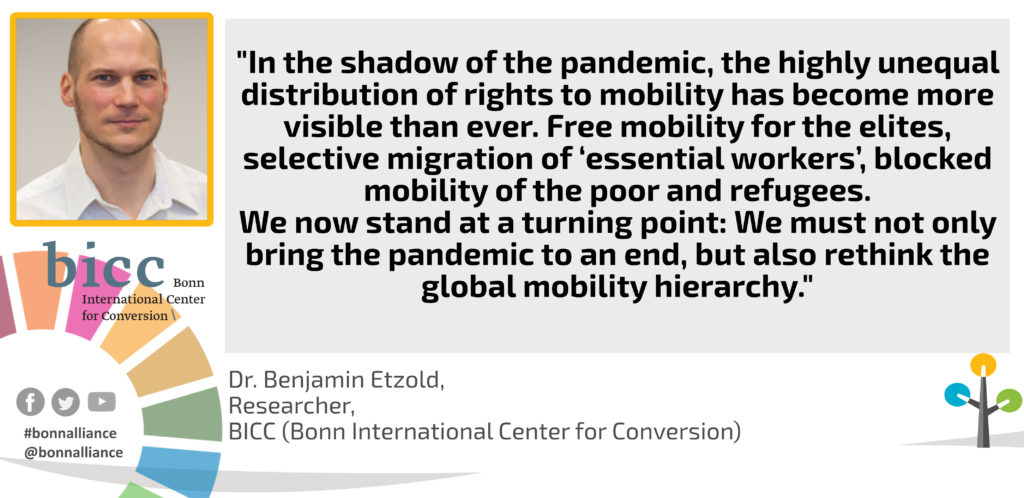
Abstract
On Lesvos in September, a long-smouldering conflict around the reception of those seeking protection went up in flames before the eyes of the world. Following the start of the pandemic in March, the Greek authorities, for fear of the coronavirus, had already largely stopped the asylum process on the Aegean islands and resettlement to the mainland. But even before that, conditions were catastrophic: In Moria camp, designed to hold just about 3,000 people, more than 12,700 asylum seekers were living under the most challenging conditions. Physical distancing was out of the question. When the first cases of infection appeared, the administration placed the entire camp under quarantine; everyone had to stay in this hopeless place. Shortly afterwards, the Moria “hotspot” went up in flames. The COVID-19 pandemic became the spark that ignited the powder keg. […]
Author: Dr. Benjamin Etzold (BICC (Bonn International Center for Conversion), Researcher)